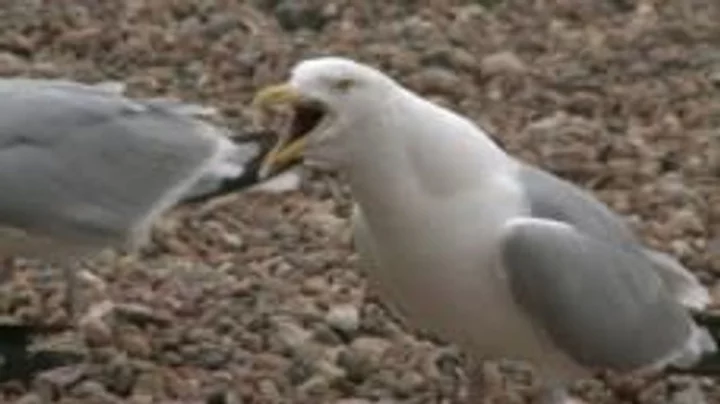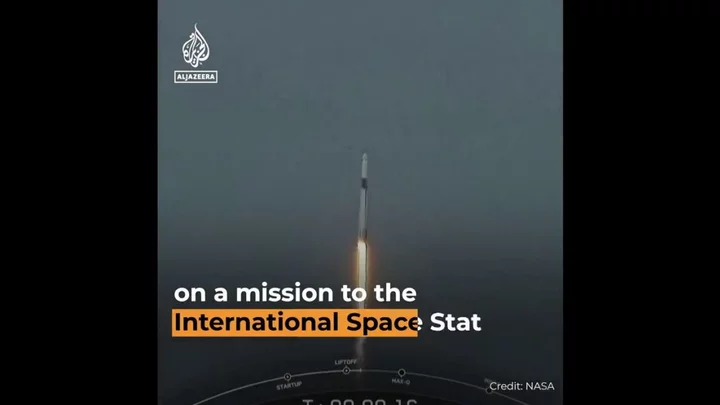
What’s Trending Today: DeSantis Twitter Glitch, Remembering Tina Turner, Oakland A’s
Welcome to Social Buzz, a daily column looking at what’s trending on social media platforms. I’m Caitlin Fichtel,
2023-05-25 22:50

Biden Taps Energy Department to Find Climate-Friendly Alternatives for Jet, Shipping Fuels
The Biden administration is marshaling the power of the Energy Department to find low-carbon alternatives to petroleum-based transportation
2023-05-24 23:27

Scientists discover why gulls always prey on people's food
Anyone who has braved a stroll along England's coastline will be aware of seagulls' tyrannical regime. They prey on people eating chips, they swoop down on unsuspecting holidaymakers licking an ice cream, and they can be quite aggressive indeed. And now, terrifying research has revealed that they are more calculating than you may have previously thought. A University of Sussex study on herring gulls at Brighton beach found that the birds choose what to eat by watching what humans are enjoying. Scientists taped green (salt and vinegar) and blue (cheese and onion) packets of Walkers crisps to tiles and placed them a few metres from gulls on Brighton beach and filmed the birds’ behaviour from a distance. In some cases, the researchers ate from one of the bags of crisps. When the scientists didn't eat, less than a fifth of gulls approached the crisp packets placed nearby. But when the researchers were snacking on crisps, 48 per cent of the birds came to check out the packets. Nearly 40 per cent of such approaches ended with gulls pecking at the crisp packets, and of these, 95 per cent were directed at the same colour packet as the scientist was eating from. Sign up to our free Indy100 weekly newsletter “We’ve shown that adult gulls are able to pay attention to the behaviour of humans and apply that to their own foraging choices,” said Franziska Feist, a biologist and first author on the study. “Given that the urbanisation of gulls is very recent, this ability must come from the gulls’ general smartness and behavioural flexibility.” “It is likely that simply deterring the public from directly feeding gulls may not be enough,” Feist said. “They are still able to observe what we eat and that would inform their ability to target waste, litter and so on.” Dr Madeleine Goumas, an expert on herring gulls at Exeter University who was not involved in the study, said: “We already know from previous research that gulls use information from people when they’re searching for food. “This study shows that we aren’t only drawing gulls’ attention to where food is, but they also learn about the type of food we’re eating. Knowing this may have implications for how we reduce negative interactions between humans and gulls, as we seem to be inadvertently teaching gulls to exploit new food items.” Meanwhile, past alarming research revealed that gulls prefer food that has been touched by people. Overall, it's giving Alfred Hitchcock's The Birds. Have your say in our news democracy. Click the upvote icon at the top of the page to help raise this article through the indy100 rankings.
2023-05-24 22:19

Black holes could contain 'hidden spacetime structures'
Black holes are the most confusing things out there in the universe and no-one really knows what they are – at least, that’s our very basic grasp of it. Now, though, a new study has posited a theory that black holes are structures created by unseen cosmic dimensions - or topological stars. And just to make it a little more confusing, these topological stars exist purely in the hypothetical realms of mathematics. Researchers at Johns Hopkins University have been exploring string theory, which posits that particles in the universe are actually tied to extra (hidden) dimensions through vibrating strings. Sign up to our free Indy100 weekly newsletter According to their findings, hypothetical topological stars could exist for real in the universe and they’re essentially formations of nothing which could appear in space. The study finds that topological stars would appear “remarkably similar to black holes in apparent size and scattering properties, while being smooth and horizonless”. The study, which was published in Physical Review D, found that these stars which until now have only existed in hypothetical form, look an awful lot like the black holes out in the universe. “String theory is a theory that reconciles quantum physics and gravity into a quantum gravity theory,” study leader Pierre Heidmann said. Speaking to Motherboard, he said: “Usually when you have a new theory like that, you have new degrees of freedom that come with it, and you can try to see what new fundamental objects can arise from that.” Co-author of the study Ibrahima Bah added: “It’s an interesting question to ask: Are there things other than a black hole [that] will give you a hint about what new physics could look like?” “But before you get there, you need to know how to tell whether you have a black hole or not, and to do that you have some prototype examples of things that are not black holes to be able to compare." As ever, black holes remain the most mysterious, and the most fascinating things out there. Have your say in our news democracy. Click the upvote icon at the top of the page to help raise this article through the indy100 rankings.
2023-05-24 20:20

'Impossible' ancient Mayan city discovered in remote jungle
It feels like every day there’s a science story that comes along ready to blow our tiny minds, and today is no exception. A series of ancient interconnected cities have been discovered in the remote El Mirador jungle Guatemala, and it’s changing our entire understanding of the ancient civilisation. More than 400 settlements have been uncovered with some dating back as far as 1,000 BC. They’re linked by roads too, and it’s led them to be described as “the first freeway system in the world”. Sign up to our free Indy100 weekly newsletter Richard Hansen, a research professor at the University of Idaho, is an expert on the project and he’d called the findings a “game-changer”. It was previously thought that the Mayan peoples were nomadic, but these cities have changed the scientific community’s understanding. Speaking to the Washington Post, Hansen said: "We now know that the Preclassic period was one of extraordinary complexity and architectural sophistication, with some of the largest buildings in world history being constructed during this time.” On top of the 110 miles of interconnected roads, the discoveries also showed evidence of organised agriculture and even hydraulic systems. The findings are the result of work which first began in 2015, which saw lidar technology uncovered signs of ancient structures below the surface. Archaeologist Enrique Hernández, from San Carlos University said about the findings: “Now there are more than 900 [settlements]… We [couldn’t] see that before. It was impossible,” he said. Have your say in our news democracy. Click the upvote icon at the top of the page to help raise this article through the indy100 rankings.
2023-05-24 19:20

Korea Space Race Heats Up as North and South Plan Launches
The two Koreas are in a space race. The North is upgrading its space center to accommodate the
2023-05-24 16:19

Ancient Mayan city discovered in remote jungle that was previously 'impossible' to find
It feels like every day there’s a science story that comes along ready to blow our tiny minds, and today is no exception. A series of ancient interconnected cities have been discovered in the remote El Mirador jungle Guatemala, and it’s changing our entire understanding of the ancient civilisation. More than 400 settlements have been uncovered with some dating back as far as 1,000 BC. They’re linked by roads too, and it’s led them to be described as “the first freeway system in the world”. Sign up to our free Indy100 weekly newsletter Richard Hansen, a research professor at the University of Idaho, is an expert on the project and he’d called the findings a “game-changer”. It was previously thought that the Mayan peoples were nomadic, but these cities have changed the scientific community’s understanding. Speaking to the Washington Post, Hansen said: "We now know that the Preclassic period was one of extraordinary complexity and architectural sophistication, with some of the largest buildings in world history being constructed during this time.” On top of the 110 miles of interconnected roads, the discoveries also showed evidence of organised agriculture and even hydraulic systems. The findings are the result of work which first began in 2015, which saw lidar technology uncovered signs of ancient structures below the surface. Archaeologist Enrique Hernández, from San Carlos University said about the findings: “Now there are more than 900 [settlements]… We [couldn’t] see that before. It was impossible,” he said. Have your say in our news democracy. Click the upvote icon at the top of the page to help raise this article through the indy100 rankings.
2023-05-24 00:29

A major change is coming to WhatsApp
Big news for WhatsApp users who are a bit trigger happy when sending risky texts. You will now be able to edit your messages sent via the platform, within 15 minutes. "From correcting a simple misspelling to adding extra context to a message, we're excited to bring you more control over your chats," the messaging service said in a blog post on Monday. "All you need to do is long-press on a sent message and choose 'Edit' from the menu for up to fifteen minutes after," it added. Edited messages will be tagged as "edited", so recipients can see the message has been changed. Sign up to our free Indy100 weekly newsletter But they won't be able to see how the message has been edited. It comes after Twitter said it was giving its paying subscribers the ability to edit their tweets last year. Tweets can be edited a few times in the 30 minutes after posting. "Tweeting will feel more approachable and less stressful," Twitter said in a blog post at the time. "You should be able to participate in the conversation in a way that makes sense to you and we'll keep working on ways that make it feel effortless to do just that," the platform added. Have your say in our news democracy. Click the upvote icon at the top of the page to help raise this article through the indy100 rankings.
2023-05-23 20:19

Tech bro millionaire injects himself with son's blood in attempt to de-age himself
Bryan Johnson, the multimillionaire tech and science entrepreneur who is trying to reverse his biological age, has taken the next odd step in his attempt to achieve this. Johnson, who has already spent millions of dollars every year trying to turn back the clock, has now revealed that he’s injected himself with his teenage son’s blood. The multimillionaire recruited his 17-year-old son, Talmage, and his 70-year-old father, Richard, for a trigenerational blood transfusion. The family travelled to a clinic in Dallas, where Talmage and Richard gave a litre of their blood for it to be converted into a batch of plasma. Bryan then donated a litre of his blood to Richard. Sign up to our free Indy100 weekly newsletter Claims that plasma from younger bodies can benefit older people’s health have been around for a while. Previously there have been studies carried out on mice, however experts say the results are inconclusive. The FDA does not recommend the blood infusions Bryan has done. "We have not learned enough to suggest this is a viable human treatment for anything." said Charles Brenner, a biochemist at City of Hope National Medical Centre in Los Angeles. The 45-year-old has previously spoken about his lifestyle, and told the BBC that there have been improvements in different parts of his body. "my left ear is 64, my fitness tests say I’m 18, my heart is 37, my diaphragm strength is 18," he said. Bryan’s mission to reverse the ageing process has been titled ‘Project Blueprint,’ and involves following a strict diet, sleep, and exercise routine. Have your say in our news democracy. Click the upvote icon at the top of the page to help raise this article through the indy100 rankings.
2023-05-23 19:51

Scientists have discovered how many T-Rex ever existed
If you’re anything like us, you were probably absolutely obsessed with dinosaurs as a child. However, did you ever stop to think about the sheer number of dinos that were wandering around the planet before they met their untimely end at the hands of an asteroid? A new study has been published which states that a whopping 1.7 billion T-Rex roamed the Earth in total across the Late Cretaceous period. It comes after researchers calculated their average lifespan, which measured up to a whopping 40 feet in length and 12 feet in height. Sign up to our free Indy100 weekly newsletter They cross referenced this with the number of eggs which survived and the sexual maturity of the animals to come up with the figure. It’s a huge number, but it’s actually far less than previously thought. A previous study from 2021 estimated that there were 800 million more of them that existed between about 90 to 66 million years ago. The research was published in Palaeontology, and evolutionary ecologist Eva Griebeler from the Johannes Gutenberg University of Mainz in Germany wrote about the findings. "Unlike my model, the generation time as well as life expectancies, gross reproduction rates, and reproductive values of individuals calculated from the previous model all strongly contradicted our current understanding of the biology of T. rex and of other theropods,” she said. "Their values also disagreed with those of large extant reptiles, birds, and mammals. All of these shortcomings of the previous model favor the assessment of individual and population characteristics of T. rex and of other extinct species using my model." Griebeler also explained how the findings suggest a lower T-Rex survival rate, as well as fewer generations of the animal and less egg laying. "All of these shortcomings of the previous model favor the assessment of individual and population characteristics of T. rex and other extinct species using my model," she wrote. Have your say in our news democracy. Click the upvote icon at the top of the page to help raise this article through the indy100 rankings.
2023-05-23 18:58

New SpaceX flight just made history thanks to its passengers
SpaceX's second private flight just made history by sending Saudi Arabia's first female astronaut towards the International Space Station. The SpaceX Falcon rocket launched from NASA's Kennedy Space Centre on Sunday night, and the astronaut and the other three passengers are expected to reach the space station in their capsule on Monday, where they will hang out for just over a week. Saudi Arabia's first astronauts in decades are stem cell researcher Rayyanah Barnawi, and Royal Saudi Air Force fighter pilot Ali al Qarni. "This is a dream come true for everyone," Barnawi said before the flight. Sign up to our free Indy100 weekly newsletter "Just being able to understand that this is possible - if me and Ali can do it, then they can do it, too." The journey was organised by Houston-based Axiom Space and the crew was led by Peggy Whitson, a former NASA astronaut who holds the US record for the most accumulated time in space - 665 days and counting. The company would not reveal how much the latest tickets cost, but previously cited per-seat prices of $55m (£44m). Have your say in our news democracy. Click the upvote icon at the top of the page to help raise this article through the indy100 rankings.
2023-05-23 00:26

Mexcian girl who was bullied at school has a higher IQ than Einstein and Stephen Hawking
A young girl who was bullied for being autistic may have a higher IQ than Stephen Hawking or Albert Einstein. Adhara Maite Pérez Sánchez, an 11-year-old from Tláhuac, Mexico, is being described as a prodigy by many after recently graduating with a degree in Systems Engineering. She is now going on to study industrial engineering. The extraordinary girl has a passion for astronomy and space, expressing the dream to become the first Mexican woman to travel to space as an astronaut and has given talks about her interest and knowledge of aerospace. She intends to become an astronaut at NASA, and is currently taking courses in astronomy and gravitational waves at the National Autonomous University of Mexico (UNAM), which is widely regarded as a top research university. Sign up to our free Indy100 weekly newsletter Adhara has also had her achievements recognised in 2021 by the Senate of the Republic, as well as being declared one of Mexico’s 100 most influential women, and appearing on the cover Marie Claire Mexico. However, life hasn’t always been easy for Adhara, who struggled with being bullied by her classmates. Often labelled as a ‘weirdo’ for her autism. Adhara was diagnosed with Asperger’s at 3 years old, but has succeeded greatly with it. Recently she has begun developing a bracelet designed to monitor the emotions of children such as herself in order to improve their communication skills. But she hasn’t let the negativity bring her down. Determined to succeed and achieve her goals in spite of what others say about her. Her inspirations include late physicist, Stephen Hawking, and Carmen Félix, a Mexican engineer currently developing a plan to launch a manned mission to Mars. Have your say in our news democracy. Click the upvote icon at the top of the page to help raise this article through the indy100 rankings.
2023-05-23 00:25
